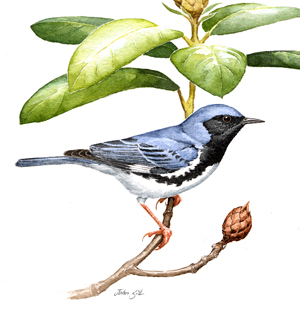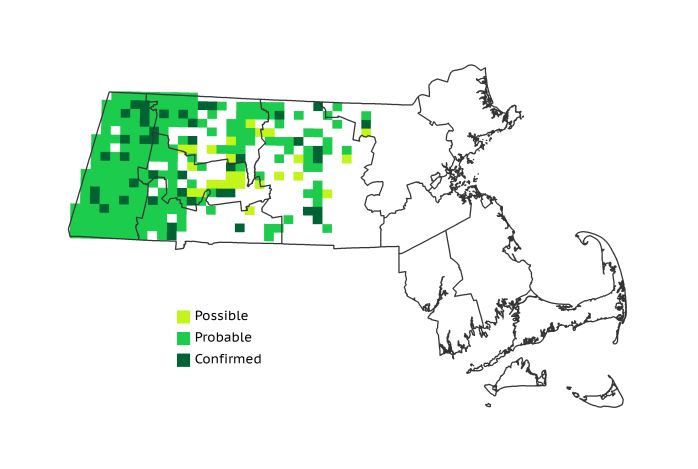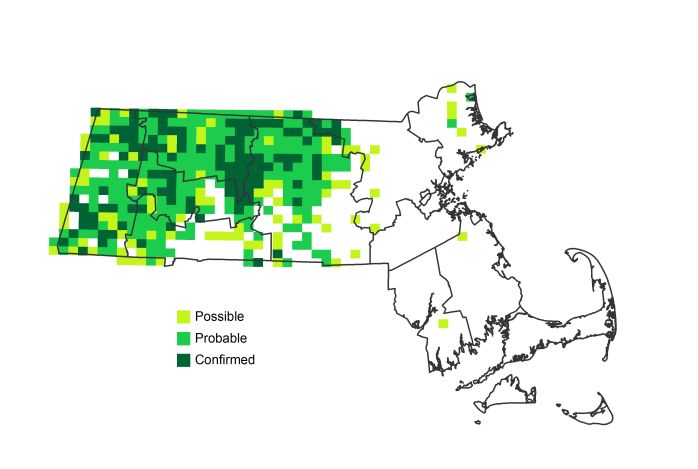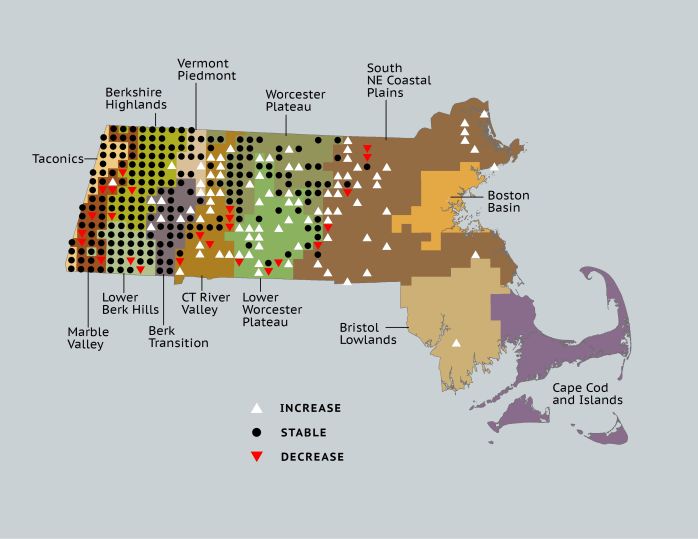Breeding Bird Atlases (BBA)
Find a Bird
Black-throated Blue Warbler
Dendroica caerulescens

Fairly widespread and likely increasing
“She made a beautiful picture. The whole effect was wonderful. The bird seemed to be sitting in a billowy mass of eider down, or cotton wool, that swelled, or rather bulged, up all around her, a regular bed of down.” – Edward Howe Forbush, Birds of Massachusetts and Other New England States
The Black-throated Blue Warbler has a relatively small breeding range that extends from Nova Scotia westward to Lake Superior. Some of these warblers breed in suitable habitat as far south as Georgia, but almost all “suitable habitat” south of Pennsylvania exists only in the Appalachian Mountains. Black-throated Blue Warblers reside primarily in mature hardwood forests, where they make their nests in dense understory growth, particularly where mountain laurel abounds. Predictably, this species suffered a significant decline in Massachusetts when much of the old-growth forest was cut down to make way for agriculture.
Historic Status
A “wayfaring and infrequent visitor” to Massachusetts in 1839 (Peabody 1839), the Black-throated Blue Warbler was known only during the migration for the next 30 years. By the 1870s, summertime lingerers in the western part of the state raised suspicion of breeding activity. By 1900, chroniclers reported that the species was increasingly more common; however, Edward Howe Forbush wrote in 1929, you had to know where to look: “This is a real wood warbler. It loves the woods.” Specifically, the Black-throated Blue Warbler preferred woods with a dense understory of Mountain Laurel (Petersen & Meservey 2003). By the time of Atlas 1, the days of using words like “uncommon” and “rare” in connection with this species in Massachusetts were over.
Atlas 1 Distribution
Black-throated Blue Warblers were found in 28% of the Commonwealth during Atlas 1. Frequently heard singing (but less commonly Confirmed) throughout the Berkshires, Black-throated Blue Warblers showed a decidedly western distribution, although their distribution mirrors many other higher altitude species with a “tail” going into the Worcester Plateau. Deciduous forest with a healthy understory of evergreen growth stood a good chance of attracting Black-throated Blue Warblers, and such forests were particularly common from the Berkshire Highlands and Lower Berkshire Hills westward. Blocks with breeding evidence were sparser moving east through the Connecticut River Valley, where the Holyoke Range provided a bridge to the central part of the state. Black-throated Blues were fairly widespread in the Worcester Plateau, especially the western part of that ecoregion, and the Lower Worcester Plateau had a fairly robust 26% block occupancy rate. Occupancy in eastern Massachusetts dwindled, however, and the Coastal Plains reported breeding evidence in only 4% (10) of blocks, all at the western edge of the region.
Atlas 2 Distribution and Change
Early ornithologists initially believed that the strikingly plumaged male and the more subdued female Black-throated Blue Warbler were separate species, but fortunately the volunteers in Atlas 1 and 2 knew better as they surveyed Massachusetts in the twenty-first century, and their motto appeared to be “Eastward Ho!” By then the species had increased its footprint to 41% of the state, and even using the effort-controlled data posts an increase over 8% of the blocks statewide. Black-throated Blues were generally persistent in the western regions, with small declines in the Berkshire Highlands and Marble Valleys balanced by growth to ubiquity in the Taconics, Vermont Piedmont, and Berkshire Transition. The most striking expansion in this species occurred in less elevated ecoregions, including the Connecticut River Valley (16 new blocks), Lower Worcester Plateau (21 new blocks), and Coastal Plains (32 new blocks).
Atlas 1 Map

Atlas 2 Map

Atlas Change Map

Ecoregion Data
Atlas 1 | Atlas 2 | Change | ||||||
Ecoregion | # Blocks | % Blocks | % of Range | # Blocks | % Blocks | % of Range | Change in # Blocks | Change in % Blocks |
Taconic Mountains | 15 | 93.8 | 5.6 | 25 | 100.0 | 5.9 | 0 | 0.0 |
Marble Valleys/Housatonic Valley | 38 | 97.4 | 14.2 | 33 | 84.6 | 7.8 | -5 | -12.8 |
Berkshire Highlands | 53 | 96.4 | 19.9 | 52 | 94.5 | 12.3 | -2 | -3.8 |
Lower Berkshire Hills | 27 | 96.4 | 10.1 | 29 | 93.5 | 6.9 | -2 | -7.4 |
Vermont Piedmont | 9 | 52.9 | 3.4 | 17 | 100.0 | 4.0 | 3 | 25.0 |
Berkshire Transition | 29 | 76.3 | 10.9 | 40 | 100.0 | 9.5 | 6 | 19.4 |
Connecticut River Valley | 17 | 30.4 | 6.4 | 34 | 52.3 | 8.1 | 10 | 20.8 |
Worcester Plateau | 50 | 64.1 | 18.7 | 87 | 98.9 | 20.6 | 7 | 14.6 |
Lower Worcester Plateau | 19 | 25.7 | 7.1 | 53 | 66.3 | 12.6 | 18 | 33.3 |
S. New England Coastal Plains and Hills | 10 | 3.7 | 3.7 | 51 | 18.0 | 12.1 | 27 | 11.9 |
Boston Basin | 0 | 0.0 | 0.0 | 0 | 0.0 | 0.0 | 0 | 0.0 |
Bristol and Narragansett Lowlands | 0 | 0.0 | 0.0 | 1 | 0.9 | 0.2 | 1 | 1.0 |
Cape Cod and Islands | 0 | 0.0 | 0.0 | 0 | 0.0 | 0.0 | 0 | 0.0 |
Statewide Total | 267 | 27.6 | 100.0 | 422 | 40.7 | 100.0 | 63 | 7.6 |
Notes
The Black-throated Blue Warbler shows a significant increasing Breeding Bird Survey trend in the Eastern US overall.



